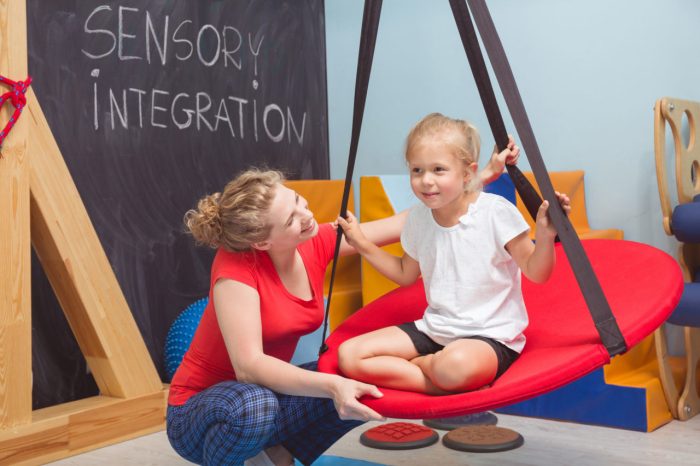The Rood approach in occupational therapy, a holistic approach that emphasizes sensory integration and motor control, has revolutionized the field. This evidence-based approach empowers occupational therapists to tailor interventions to individual needs, improving functional outcomes for a wide range of conditions.
The Rood approach is rooted in the belief that sensory processing and motor function are inextricably linked. By addressing sensory integration deficits and improving motor control, occupational therapists can enhance overall function and participation in daily activities.
Definition and Overview

A rood approach in occupational therapy is a holistic and client-centered approach that emphasizes the integration of sensory and motor functions to promote optimal occupational performance. It is based on the belief that the brain and body are inextricably linked and that sensory processing and motor control are essential for successful engagement in daily activities.
The rood approach was developed by Margaret Rood, an American occupational therapist, in the mid-20th century. It is grounded in neurophysiological research and draws upon principles from sensory integration, motor learning, and developmental psychology.
Components and Principles
Key Components
- Sensory integration: The ability to process and organize sensory information from the environment and the body.
- Motor control: The ability to plan, execute, and coordinate movement.
- Occupational performance: The ability to engage in meaningful and purposeful activities that are essential for daily life.
Guiding Principles
- Holistic approach: The client is viewed as a whole person, and interventions are tailored to their individual needs.
- Client-centered: The client is actively involved in the assessment and intervention process.
- Sensory-motor integration: Sensory and motor functions are integrated to promote optimal occupational performance.
- Developmental approach: Interventions are based on the client’s developmental stage and needs.
Assessment and Intervention

Assessment Process
The assessment process in a rood approach typically involves:
- Observation of the client’s sensory processing and motor skills
- Sensory integration testing
- Motor control testing
- Occupational performance assessment
Intervention Tailoring
Interventions are tailored to the individual needs of the client and may include:
- Sensory integration activities: These activities help to improve the client’s ability to process and organize sensory information.
- Motor control exercises: These exercises help to improve the client’s ability to plan, execute, and coordinate movement.
- Occupational therapy activities: These activities help the client to engage in meaningful and purposeful activities that are essential for daily life.
Applications and Evidence
Range of Conditions, Rood approach in occupational therapy
A rood approach can be used to treat a wide range of conditions, including:
- Autism spectrum disorder
- Cerebral palsy
- Down syndrome
- Sensory processing disorder
- Motor coordination disorder
Evidence-Based Research
There is a growing body of evidence to support the effectiveness of a rood approach in occupational therapy. Studies have shown that it can improve sensory processing, motor control, and occupational performance in children and adults with a variety of conditions.
Advantages and Disadvantages
Advantages
- Holistic approach
- Client-centered
- Sensory-motor integration
- Evidence-based
Disadvantages
- Can be time-consuming
- Requires specialized training
- May not be suitable for all clients
Training and Education
Training Requirements
Occupational therapists who wish to use a rood approach must complete specialized training. This training typically includes:
- Coursework in sensory integration, motor control, and occupational therapy
- Supervised clinical experience
- Certification in a rood approach
Availability of Workshops and Courses
There are a number of workshops and courses available that can provide occupational therapists with the training they need to use a rood approach. These workshops and courses are typically offered by professional organizations, such as the American Occupational Therapy Association (AOTA).
Future Directions

Emerging Trends
There are a number of emerging trends in the field of rood approach, including:
- The use of technology to enhance assessment and intervention
- The development of new interventions that are tailored to the specific needs of different client populations
- The integration of rood approach principles into other areas of occupational therapy, such as mental health and geriatrics
Potential Applications
There are a number of potential applications for rood approach in the future, including:
- The prevention of developmental disabilities
- The treatment of chronic pain
- The rehabilitation of individuals with traumatic brain injuries
Quick FAQs: Rood Approach In Occupational Therapy
What is the Rood approach in occupational therapy?
The Rood approach is a holistic approach that emphasizes sensory integration and motor control to improve functional outcomes for individuals with sensory processing and motor impairments.
How does the Rood approach differ from other occupational therapy approaches?
The Rood approach is unique in its focus on sensory integration and motor control, and its emphasis on individualized interventions tailored to the specific needs of each client.
What conditions can benefit from the Rood approach?
The Rood approach can benefit individuals with a wide range of conditions, including cerebral palsy, autism spectrum disorder, sensory processing disorder, and developmental delays.